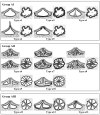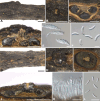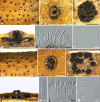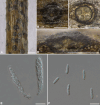Cytospora: an important genus of canker pathogens
- PMID: 39717654
- PMCID: PMC11663427
- DOI: 10.3114/sim.2024.109.05
Cytospora: an important genus of canker pathogens
Abstract
Cytospora species have commonly been reported as important plant pathogenic fungi with wide host ranges and geographic distributions. With the increase in the number of cryptic species being described, a comprehensive global taxonomic revision of the genus Cytospora is required. The present study includes 399 isolates from 32 countries. These isolates were subjected to DNA sequence analysis for five genomic loci (ITS, act1, rpb2, tef1-α and tub2). Based on these data, it could be confirmed that Cytospora, Leucostoma, Valsa, Valsella and Valseutypella are congeneric. Furthermore, 111 species of Cytospora could also be reassessed, 44 species and four combinations newly introduced, and new typifications proposed for a further three species. Three asexual morphological groups (including 13 asexual morphological types) and three sexual morphological groups (including eight sexual morphological types) were designated. The present study explored the species diversity of Cytospora and re-evaluated the identity of all cultures in the Westerdijk Fungal Biodiversity Institute (Utrecht, The Netherlands) that were deposited as either Cytospora or as one of its related genera. This is the most comprehensive phylogenetic analysis thus far conducted on Cytospora and the results contribute to an increased understanding of the taxonomy of these important fungi. It is also hoped that the findings will lead to improved management strategies for diseases associated Cytospora species. Taxonomic novelties: New species: Cytospora acericola X.L. Fan & C.M. Tian, C. adamsii Jami, Crous & M.J. Wingf., C. beijingensis L. Lin & X.L. Fan, C. betulae Jami, Crous & M.J. Wingf., C. brabeji Jami, Crous & M.J. Wingf., C. castaneicola L. Lin & X.L. Fan, C. cerebriformis L. Lin & X.L. Fan, C. conceptaculata L. Lin & X.L. Fan, C. crataegina X.L. Fan & C.M. Tian, C. deqinensis L. Lin & X.L. Fan, C. diqingensis L. Lin & X.L. Fan, C. eastringensis L. Lin & X.L. Fan, C. elaeagnina L. Lin & X.L. Fan, C. fraxinea X.L. Fan & C.M. Tian, C. guyuanensis L. Lin & X.L. Fan, C. jiufengensis L. Lin & X.L. Fan, C. lauricola L. Lin & X.L. Fan, C. lhasaensis L. Lin & X.L. Fan, C. lijiangensis L. Lin & X.L. Fan, C. lvxinensis L. Lin & X.L. Fan, C. malvicolor X.L. Fan & C.M. Tian, C. multiseriata L. Lin & X.L. Fan, C. nanyangensis X.L. Fan & C.M. Tian, C. polyspora X.L. Fan & C.M. Tian, C. pseudochrysosperma L. Lin & X.L. Fan, C. qinghaiensis L. Lin & X.L. Fan, C. qingshuiensis L. Lin & X.L. Fan, C. sanbaensis L. Lin & X.L. Fan, C. shaanxiensis L. Lin & X.L. Fan, C. shangrilaensis L. Lin & X.L. Fan, C. sidaohensis L. Lin & X.L. Fan, C. sinensis L. Lin & X.L. Fan, C. songshanensis L. Lin & X.L. Fan, C. suecica Jami, Crous & M.J. Wingf., C. syringina L. Lin & X.L. Fan, C. tenebrica L. Lin & X.L. Fan, C. tetraspora L. Lin & X.L. Fan, C. tongzhouensis X.L. Fan & C.M. Tian, C. uniloculata L. Lin & X.L. Fan, C. washingtonensis Jami, Crous & M.J. Wingf., C. xiaolongmenensis L. Lin & X.L. Fan, C. yinchuanensis L. Lin & X.L. Fan, C. yuduensis L. Lin & X.L. Fan, C. yulinensis L. Lin & X.L. Fan. New combinations: Cytospora auerswaldii (Nitschke) L. Lin & X.L. Fan, C. multicollis (Checa et al.) L. Lin, X.L. Fan & Crous, C. tristicha (De Not.) L. Lin, X.L. Fan & Crous, C. weiriana (Petr.) X.L. Fan & Crous. New replacement names: Cytospora desmazieri L. Lin, X.L. Fan & Crous, C. fuckeliana L. Lin, X.L. Fan & Crous, C. hoffmannii L. Lin, X.L. Fan & Crous, C. massarii L. Lin, X.L. Fan & Crous, C. nitschkeana L. Lin, X.L. Fan & Crous, C. saccardoi L. Lin, X.L. Fan & Crous. New synonyms: Cytospora ampulliformis Norph., Bulgakov, T.C. Wen & K.D. Hyde, C. brevispora (G.C. Adams & Jol. Roux) G.C. Adams & Rossman, C. cenisia Sacc., C. ceratospermopsis C.M. Tian & X.L. Fan, C. cotini Norph., Bulgakov & K.D. Hyde, C. ershadii Zafari & Hanifeh, C. erumpens Norph., Bulgakov, T.C. Wen & K.D. Hyde, C. fraxinigena Senan., Camporesi & K.D. Hyde, C. galegicola Q.J. Shang, E. Camporesi & K.D. Hyde, C. granati D.P. Lawr., L.A. Holland & Trouillas, C. hippophaicola Spetik, Eichmeier, Gramaje, Stuskova & Berraf-Tebbal, C. massariana Sacc., C. nivea (Hoffm.) Sacc., C. parakantschavelii Norph., Bulgakov, T.C. Wen & K.D. Hyde, C. parasitica Norph., Bulgakov & K.D. Hyde, C. paratranslucens Norph., Bulgakov, T.C. Wen & K.D. Hyde, C. pini Desm., C. populicola D.P. Lawr., L.A. Holland & Trouillas, C. predappioensis Q.J. Shang, Norph., Camporesi & K.D. Hyde, C. quercicola Senan., Camporesi & K.D. Hyde, C. rosae Senan., Camporesi & K.D. Hyde, C. salicella Sacc., C. vinacea D.P. Lawr., Travadon & Pouzoulet, Valsa germanica Nitschke, V. massariana De Not., V. nivea (Hoffm.) Fr., Valsella salicis Fuckel, Sphaeria nivea Hoffm. Typification: Lecto- and epitypifications (basionyms): Sphaeria chrysosperma Pers., Valsa eucalypti Cooke & Harkn., Valsella salicis Fuckel. Citation: Lin L, Fan XL, Groenewald JZ, Jami F, Wingfield MJ, Voglmayr H, Jaklitsch W, Castlebury LA, Tian CM, Crous PW (2024). Cytospora: an important genus of canker pathogens. Studies in Mycology 109: 323-401. doi: 10.3114/sim.2024.109.05.
Keywords: Cytosporaceae; Diaporthales; multi-gene phylogeny; taxonomy.
© 2024 Westerdijk Fungal Biodiversity Institute.
Conflict of interest statement
The authors declare that there is no conflict of interest.
Figures




































































Similar articles
-
Genera of phytopathogenic fungi: GOPHY 4.Stud Mycol. 2022 Jul;101:417-564. doi: 10.3114/sim.2022.101.06. Epub 2022 Jun 2. Stud Mycol. 2022. PMID: 36059898 Free PMC article.
-
Phylogenetic revision of Camarosporium (Pleosporineae, Dothideomycetes) and allied genera.Stud Mycol. 2017 Jun;87:207-256. doi: 10.1016/j.simyco.2017.08.001. Epub 2017 Aug 23. Stud Mycol. 2017. PMID: 28966419 Free PMC article.
-
Diaporthe species on palms - integrative taxonomic approach for species boundaries delimitation in the genus Diaporthe, with the description of D. pygmaeae sp. nov.Stud Mycol. 2024 Dec;109:487-594. doi: 10.3114/sim.2024.109.08. Epub 2024 Oct 23. Stud Mycol. 2024. PMID: 39717652 Free PMC article.
-
Families of Diaporthales based on morphological and phylogenetic evidence.Stud Mycol. 2017 Mar;86:217-296. doi: 10.1016/j.simyco.2017.07.003. Epub 2017 Aug 1. Stud Mycol. 2017. PMID: 28947840 Free PMC article.
-
Revising Clonostachys and allied genera in Bionectriaceae.Stud Mycol. 2023 Jun;105:205-266. doi: 10.3114/sim.2023.105.03. Epub 2023 Jun 12. Stud Mycol. 2023. PMID: 38895704 Free PMC article.
Cited by
-
Fungal Planet description sheets: 1697-1780.Fungal Syst Evol. 2024 Dec;14:325-577. doi: 10.3114/fuse.2024.14.19. Epub 2024 Dec 6. Fungal Syst Evol. 2024. PMID: 39830292 Free PMC article.
-
Comprehensive genome analysis of two Cytospora (Cytosporaceae, Diaporthales) species associated with canker disease of spruce: C.piceae and C.piceicola sp. nov.MycoKeys. 2025 May 5;117:89-119. doi: 10.3897/mycokeys.117.145445. eCollection 2025. MycoKeys. 2025. PMID: 40364895 Free PMC article.
-
Fungal Planet description sheets: 1781-1866.Persoonia. 2025 Jun;54:327-587. doi: 10.3114/persoonia.2025.54.10. Epub 2025 Jul 8. Persoonia. 2025. PMID: 40746709 Free PMC article.
-
Roles of NADPH oxidases in regulating redox homeostasis and pathogenesis of the poplar canker fungus Cytospora chrysosperma.Stress Biol. 2025 May 8;5(1):33. doi: 10.1007/s44154-025-00223-y. Stress Biol. 2025. PMID: 40338399 Free PMC article.
-
Cytosporalongdensis sp. nov. and C.sinensis (Diaporthales, Valsaceae) associated with Populusalba subsp. pyramidalis canker and dieback in China.MycoKeys. 2025 Jun 13;118:345-359. doi: 10.3897/mycokeys.118.152880. eCollection 2025. MycoKeys. 2025. PMID: 40636814 Free PMC article.
References
-
- Abebe G, Hart JH, Adams RD. (1990). The relationship of site factors to the incidence of Cytospora and Septoria cankers and poplar and willow borer in hybrid poplar plantations. General Technical Report-North Central Forest Experiment Station, USDA Forest Service: 163–171.
-
- Adams GC, Roux J, Wingfield MJ. (2006). Cytospora species (Ascomycota, Diaporthales, Valsaceae): introduced and native pathogens of trees in South Africa. Australasian Plant Pathology 35: 521–548.
-
- Adams GC, Wingfield WJ, Common R. et al. (2005). Phylogenetic relationships and morphology of Cytospora species and related teleomorphs (Ascomycota, Diaporthales, Valsaceae) from Eucalyptus. Studies in Mycology 52: 1–144.
-
- Adanson M. (1763). Familles des Plantes. Vincent, Paris, France.
-
- Ariyawansa HA, Hyde KD, Jayasiri SC. et al. (2015). Fungal diversity notes 111–252 taxonomic and phylogenetic contributions to fungal taxa. Fungal Diversity 75: 27–274.
LinkOut - more resources
Full Text Sources
